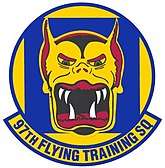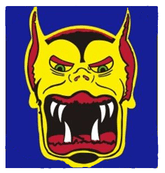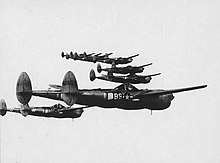97th Flying Training Squadron
The 97th Flying Training Squadron is part of the 340th Flying Training Group and is the Reserve associate to the 80th Flying Training Wing based at Sheppard Air Force Base, Texas.
| 97th Flying Training Squadron | |
|---|---|
 North American F-86L Sabre 53-704 at Wright-Patterson AFB 1954[note 1] | |
| Active | 1942-1945; 1947-1949; 1950-1958; 1973-1993; 1998-Present |
| Country | |
| Branch | |
| Role | Pilot Training |
| Part of | Air Force Reserve Command 10th Air Force 340th Flying Training Group |
| Garrison/HQ | Sheppard Air Force Base |
| Nickname(s) | Devil Cats |
| Engagements | European Theater of Operations Mediterranean Theater of Operations |
| Decorations | Distinguished Unit Citation Air Force Outstanding Unit Award |
| Insignia | |
| 97th Flying Training Squadron Emblem [note 2] |  |
| 97th Fighter Squadron emblem (approved 30 October 1942)[1] |  |
The 97th flew combat in the European Theater of Operations and the Mediterranean Theater of Operations between 25 December 1942 and 3 May 1945. It flew fighter escort and air defense from, 1947–1949 and air defense from, 1951-1957.
The squadron was redesignated as the 97th Flying Training Squadron and trained USAF pilots to fly supersonic jet aircraft from 1973 to 1993. Since 1998 it has trained fighter pilots for the United States as well as America's European and NATO allies.
Mission
The squadron operates Beechcraft T-6A Texan II and Northrop T-38 Talon aircraft conducting flight training for the Euro-NATO Joint Jet Pilot Training Program (ENJJPT) with highly experienced Air Force Reserve instructor pilots.
History
World War II

The squadron was first activated in early 1942 at Harding Field, Louisiana as the 97th Pursuit Squadron,[2] one of the original three squadrons of the 82d Pursuit Group.[3] It soon moved to California where it equipped with Lockheed P-38 Lightnings and began training with Fourth Air Force as the 97th Fighter Squadron. It left California in the fall and sailed for Northern Ireland, where it received additional combat training under Eighth Air Force. A month after the initial Operation Torch landings in North Africa the squadron deployed to Algeria, where it entered combat as an element of Twelfth Air Force.[4]
In North Africa, the squadron flew antisubmarine patrols, bomber escort missions and attacked enemy shipping and airfields, moving its base east through Algeria and Tunisia. As the North African campaign drew to a close, the unit began attacking targets in Italy, earning a Distinguished Unit Citation[2] for its actions on 25 April 1943 during an attack on enemy airfields in Foggia.[4]
In September, the squadron participated in Operation Husky, the invasion of Sicily, during which it was awarded a second Distinguished Unit Citation for a bomber escort mission against marshalling yards near Naples.[2][4] The squadron moved to Italy, where it became part of Fifteenth Air Force as part of the buildup to providee fighter cover for Fifteenth's heavy bombers.[4] On 10 June 1944 the squadron earned a third Distinguished Unit Citation for its actions during an attack on oil refineries in Ploiești, Romania.[2]
Following the surrender of Germany, the squadron remained in Italy until September 1945, when it was inactivated[2] In the course of the war the squadron was credited with the destruction of 146 enemy aircraft.[5]
Cold War
In 1947 the squadron was again activated at Grenier Field, New Hampshire, where it was equipped with North American P-51 Mustangs as a Strategic Air Command fighter escort unit.[1] Between April and June 1948 the squadron deployed to Ladd Air Force Base, Alaska, where it practiced rendezvousing with and escorting bombers, intercepting simulated enemy bombers and aerial gunnery.[4] In August 1949 it was transferred to Continental Air Command and its primary role became air defense, but this mission change was brief, for the squadron was inactivated in October.[1]
In late 1950, the squadron, now designated the 97th Fighter-Interceptor Squadron, was activated under Air Defense Command (ADC) at Wright-Patterson Air Force Base, Ohio and soon began to equip with North American F-86 Sabres. Although it was assigned to Eastern Air Defense Force, in the first year it was active, it was attached to both the 56th and 142d Fighter-Interceptor Wings.[2] This was due to ADC's difficulty under the existing wing base organizational structure in deploying fighter squadrons to best advantage.[6] As a result, in February 1952 ADC reorganized its fighter forces on a regional basis, and the squadron was reassigned to the 4706th Defense Wing.[2]
In August 1955, ADC implemented Project Arrow, which was designed to bring back on the active list the fighter units which had compiled memorable records in the two world wars.[7] Project Arrow was also designed to reunite fighter squadrons with their traditional headquarters. As a result, the 97th moved on paper to New Castle County Airport, Delaware,[2] where it assumed the mission, personnel, and Mighty Mouse Rocket armed Lockheed F-94 Starfire aircraft of the 332d Fighter-Interceptor Squadron, which moved on paper to McGuire Air Force Base, New Jersey.[8] Meanwhile, the 97th's personnel and equipment at Wright-Patterson were assigned to the 56th Fighter-Interceptor Squadron.[9] The squadron remained at New Castle until it was inactivated in 1958.[2]
Flying Training
In 1972 Air Training Command replaced its Major Command (MAJCOM) controlled flying training units with USAF controlled units (AFCON) units. As part of this program the squadron was redesignated the 97th Flying Training Squadron and activated at Williams Air Force Base, Arizona when its parent 82d Flying Training Wing replaced the 3525th Pilot Training Wing. At Williams the unit trained USAF pilots to fly Northrop T-38 Talon supersonic jet aircraft[1] in the advanced phase of the Undergraduate Pilot Training program. The squadron was inactivated in 1993 when Williams closed in the second round of the Base Realignment and Closure program.[4]
In 1998, the 97th Flying Training Squadron was activated in the Air Force Reserve at Sheppard Air Force Base, Texas[1] as an associate of the 80th Flying Training Wing. The 80th wing conducts the European-North Atlantic Treaty Organization Joint Jet Pilot Training Program. The squadron also uses the T-38C in the Introduction to Fighter Fundamentals course (IFF), an advanced pilot course that teaches basic fighter maneuvers.[10] As the reserve associate unit for these programs the squadron uses Air Force Reserve instructor pilots to perform student training.[1]
Lineage
- Constituted as the 97th Pursuit Squadron (Interceptor) on 13 January 1942
- Activated on 9 February 1942
- Redesignated 97th Pursuit Squadron (Interceptor) (Twin Engine) on 22 April 1942
- Redesignated 97th Fighter Squadron (Twin Engine) on 15 May 1942
- Redesignated 97th Fighter Squadron, Two Engine on 28 February 1944
- Inactivated on 9 September 1945
- Activated on 12 April 1947 *
- Redesignated 97th Fighter Squadron, Single Engine on 15 August 1947
- Inactivated on 2 October 1949
- Redesignated 97th Fighter-Interceptor Squadron on 13 November 1950
- Activated on 1 December 1950
- Inactivated on 8 January 1958
- Redesignated 97th Flying Training Squadron on 22 June 1972
- Activated on 1 February 1973
- Inactivated on 1 April 1993
- Activated on 1 April 1998[1]
Assignments
- 82d Pursuit Group (later 82d Fighter Group), 9 February 1942 - 9 September 1945
- 82d Fighter Group, 12 April 1947 -2 October 1949
- Eastern Air Defense Force, 1 December 1950 (attached to 56th Fighter-Interceptor Wing until 20 May 1951, then to 142d Fighter-Interceptor Wing)
- 4706th Defense Wing (later 4706th Air Defense Wing), 6 February 1952
- 82d Fighter Group, 18 August 1955 – 8 January 1958
- 82d Flying Training Wing, 1 February 1973 –
- 82d Operations Group, 15 December 1991 - 1 April 1993
- 340th Flying Training Group, 1 April 1998 – Present[1]
Stations
|
|
Aircraft
|
|
Awards and Campaigns
| Award streamer | Award | Dates | Notes |
|---|---|---|---|
| Distinguished Unit Citation | 25 April 1943 | 97th Fighter Squadron, Italy[2] | |
| Distinguished Unit Citation | 2 September 1943 | 97th Fighter Squadron, Italy[2] | |
| Distinguished Unit Citation | 10 June 1944 | 97th Fighter Squadron, Ploiești, Romania[2] | |
| Air Force Outstanding Unit Award | 1 January 1978-30 April 1979 | 97th Flying Training Squadron[1] | |
| Air Force Outstanding Unit Award | 1 May 1983-30 April 1985 | 97th Flying Training Squadron[1] | |
| Air Force Outstanding Unit Award | 1 June 1988-31 May 1990 | 97th Flying Training Squadron[1] | |
| Air Force Outstanding Unit Award | 1 April 1991-31 March 1993 | 97th Flying Training Squadron[1] |
| Campaign Streamer | Campaign | Dates | Notes |
|---|---|---|---|
| Air Offensive, Europe | 3 October 1942 – 5 June 1944 | 97th Fighter Squadron[2] | |
| Tunisia | 24 December 1942 – 13 May 1943 | 97th Fighter Squadron[2] | |
| Sicily | 14 May 1943 – 17 August 1943 | 97th Fighter Squadron[2] | |
| Naples-Foggia | 18 August 1943 – 21 January 1944 | 97th Fighter Squadron[2] | |
| Rome-Arno | 22 January 1944 – 9 September 1944 | 97th Fighter Squadron[2] | |
| Normandy | 6 June 1944 – 24 July 1944 | 97th Fighter Squadron[2] | |
| Northern France | 25 July 1944 – 14 September 1944 | 97th Fighter Squadron[2] | |
| Southern France | 15 August 1944 – 14 September 1944 | 97th Fighter Squadron[2] | |
| North Apennines | 10 September 1944 – 4 April 1945 | 97th Fighter Squadron[2] | |
| Rhineland | 15 September 1944 – 21 March 1945 | 97th Fighter Squadron[2] | |
| Central Europe | 22 March 1944 – 21 May 1945 | 97th Fighter Squadron[2] | |
| Po Valley | 3 April 1945 – 8 May 1945 | 97th Fighter Squadron[2] | |
| Air Combat, EAME Theater | 3 October 1942 – 11 May 1945 | 97th Fighter Squadron[2] |
See also
References
Notes
Explanatory Notes
- This aircraft is now on static display at the Travis AFB museum in California
- The emblem is the stylized face of a Devil Cat, which is neither cat nor wolf and supposedly has roamed the steppes of Russia for generations. Its awesome appearance indicates the beast's true ferocity and diabolical wiliness and daring. No animal, real or imaginary, excites greater respect or fear among the peoples of the steppes than the Devil Cat. History of the 80th Flying Training Wing,
Citations
- Haulman, Daniel L. (April 1, 2008). "Factsheet 97 Flying Training Squadron (AFRC)". Air Force Historical Research Agency. Retrieved September 4, 2017.
- Maurer, Combat Squadrons, p. 321
- Maurer, Combat Units, pp. 147–149
- A Brief History of the 82d Flying Training Wing and Sheppard AFB
- Newton & Senning, pp. 583-584. The official total was 145.98 due to shared victories and rounding.
- Grant, p. 33
- Buss, et al., p.6
- Maurer, Combat Squadrons, p. 410
- Maurer, Combat Squadrons, p. 227
- 80th Flying Training Wing History Office, History of the 80th Flying Training Wing, Sheppard AFB, Texas Archived 2012-08-09 at the Wayback Machine (April 2012) retrieved November 15, 2013
- Except as indicated, aircraft flown are from Haulman.
Bibliography
![]()
- Buss, Lydus H.(ed), Sturm, Thomas A., Volan, Denys, and McMullen, Richard F., History of Continental Air Defense Command and Air Defense Command July to December 1955, Directorate of Historical Services, Air Defense Command, Ent AFB, CO, 1956
- Cornett, Lloyd H; Johnson, Mildred W (1980). A Handbook of Aerospace Defense Organization, 1946–1980 (PDF). Peterson AFB, CO: Office of History, Aerospace Defense Center.
- Grant, C. L. "The Development of Continental Air Defense to 1 September 1954, USAF Historical Study No. 126" (PDF). Research Studies Institute, USAF Historical Division, Air University. Retrieved June 26, 2017.
- Maurer, Maurer, ed. (1983) [1961]. Air Force Combat Units of World War II (PDF) (reprint ed.). Washington, DC: Office of Air Force History. ISBN 0-912799-02-1.
- Maurer, Maurer, ed. (1982) [1969]. Combat Squadrons of the Air Force, World War II (PDF) (reprint ed.). Washington, DC: Office of Air Force History. ISBN 0-405-12194-6.
- Newton, Wesely P., Jr.; Senning, Calvin F. (1963). "USAF Credits for the Destruction of Enemy Aircraft, World War II, USAF Historical Study No. 85" (PDF). Research Studies Institute, USAF Historical Division, Air University. Retrieved June 26, 2017.
- "History of the 80th Flying Training Wing, Sheppard AFB, Texas" (PDF). 80th Flying Training Wing History Office. April 2012. Archived from the original (PDF) on September 24, 2015. Retrieved September 4, 2017.
- "A Brief History of the 82d Flying Training Wing and Sheppard AFB" (PDF). 82d Training Wing History Office. January 2, 2008. Archived from the original (PDF) on February 19, 2013. Retrieved November 15, 2013.
Further reading
- Anonymous (1949). 82nd Fighter. Robert W. Kelly Publishing Co.
- Blake, Steven (2012). P-38 Lighting Aces of the 82nd Fighter Group in World War II. Aircraft of the Aces. Vol 108. Osprey Publishing. ISBN 978-1-780968-71-1.
- Blake, Steven (1992). Adorimini:"Up and at 'Em" A History of the 82nd Fighter Group in World War II. Boise, ID: Walsworth Publishing Co.
- Leonard, Barry (2009). History of Strategic Air and Ballistic Missile Defense (PDF). Vol II, 1955-1972. Fort McNair, DC: Center for Military History. ISBN 978-1-43792-131-1.
- Watkins, Robert A. (2009). Insignia and Aircraft Markings of the U.S. Army Air Force In World War II. Volume IV, European-African-Middle Eastern Theater of Operations. Atglen,PA: Shiffer Publishing, Ltd. ISBN 978-0-7643-3401-6.
- "ADCOM's Fighter Interceptor Squadrons". The Interceptor. Aerospace Defense Command. 21 (1): 5–11, 26–31, 40–45, 54–59. January 1979.


